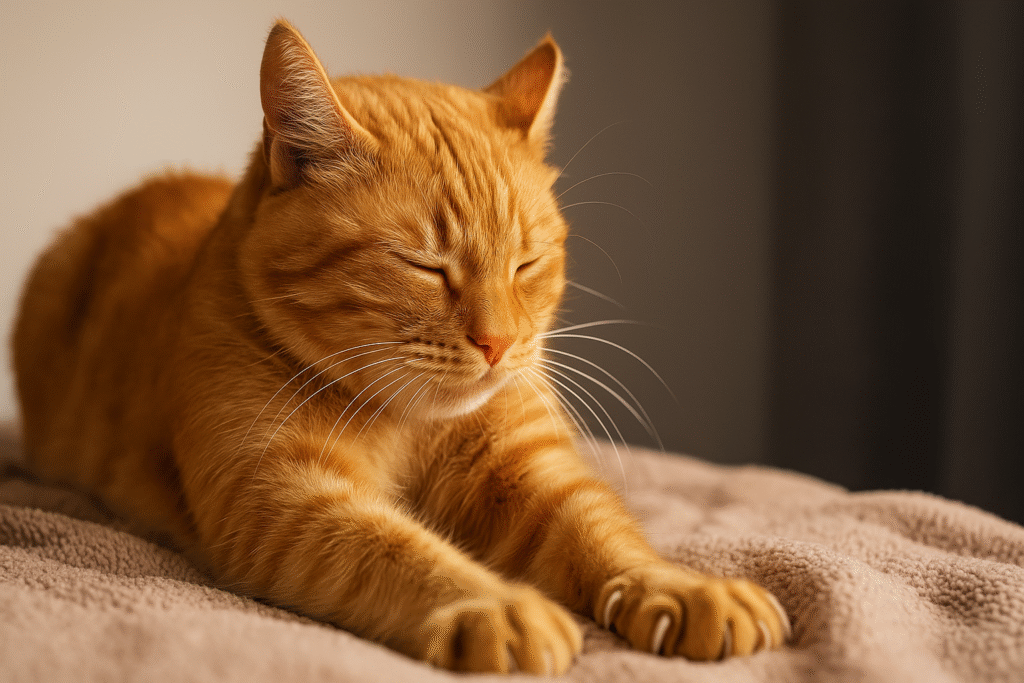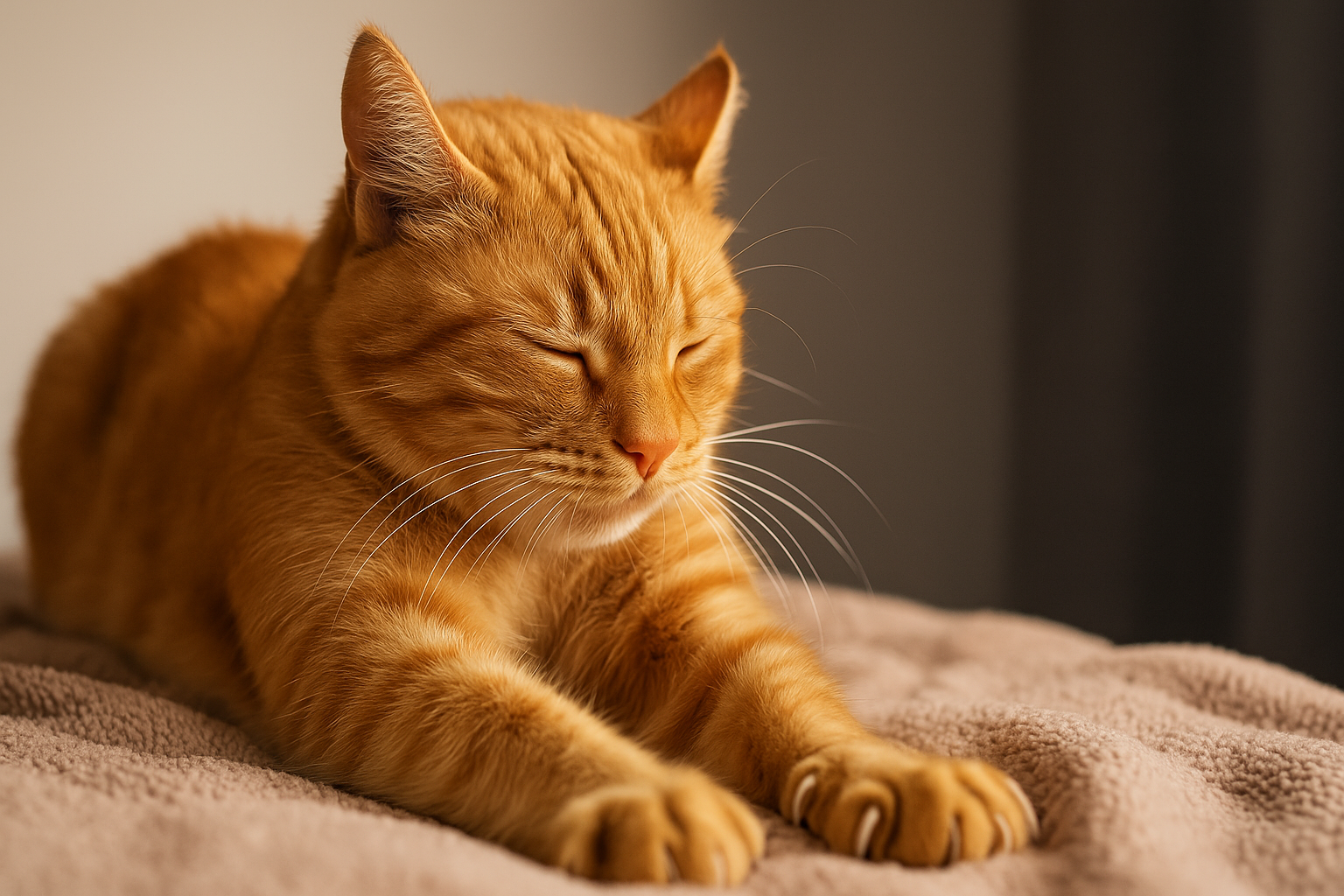Cats are mysterious creatures, and their behaviors often leave us both charmed and puzzled. One of the most common and endearing feline habits is kneading, sometimes called “making biscuits.”
If you’ve ever watched a cat rhythmically push its paws into a soft blanket, pillow, or even your lap, you may have wondered why they do this. Is it a sign of affection? Is it instinct? Or is there a deeper scientific explanation behind this quirky action?
In this comprehensive article, we will explore the science and psychology behind why cats knead, what this behavior means for both kittens and adult cats, and how it relates to their instincts, emotions, and relationships with humans.
We’ll also address when kneading might signal a problem and how you can manage this behavior in your home. All information is based on credible sources and current scientific understanding, ensuring you get the most accurate and helpful insights.
What Is Cat Kneading?
Kneading is the rhythmic motion cats make by alternately pushing their front paws into a soft surface, such as a blanket, pillow, or even a human’s lap. This action usually involves extending and retracting their claws and often occurs when the cat is relaxed or content. The behavior is so distinctive that it’s earned the nickname “making biscuits,” as it looks like the cat is kneading dough.
Kneading is not limited to any particular breed, age, or gender. Cats of all kinds, from tiny kittens to senior felines, may knead at various times throughout their lives. The frequency and intensity can vary widely between individual cats, but the action itself is a universal feline trait.

The Origins of Kneading: Instincts from Kittenhood
To understand why cats knead, it helps to look at their earliest days. Kittens begin kneading almost as soon as they are born. While nursing, kittens press their tiny paws against their mother’s belly to stimulate the flow of milk.
This kneading motion helps them get the nourishment they need and creates a strong association between the act of kneading and feelings of comfort, warmth, and security.
As kittens grow and eventually stop nursing, the kneading behavior often persists. Many experts believe that adult cats knead because the action is linked to those comforting early experiences. For a cat, kneading can be a way to self-soothe, relax, and recreate the positive feelings from kittenhood.
The Science: What Happens When a Cat Kneads?
While the exact science of kneading is still being explored, several theories have emerged to explain why cats continue this behavior into adulthood. Here are the most widely accepted explanations, supported by feline behaviorists and veterinarians:
1. Comfort and Contentment
Kneading is most commonly seen when a cat is relaxed, such as when settling down for a nap or enjoying a cuddle with a trusted human. The repetitive motion appears to help cats release tension and enter a state of calm. Some research suggests that kneading may stimulate the release of endorphins in the cat’s brain, further enhancing their sense of well-being.
2. Marking Territory
Cats have scent glands located in their paw pads. When they knead a surface, they release pheromones that mark the area with their unique scent. This subtle form of scent marking helps cats establish a sense of ownership and security in their environment. By kneading your lap or their favorite blanket, your cat is essentially claiming it as their own.
3. Nesting Instincts
In the wild, ancestral cats would knead grass or leaves to create a soft, comfortable spot for resting or giving birth. This nesting behavior is thought to be hardwired into domestic cats as well. When your cat kneads a blanket before lying down, they may be instinctively preparing their “nest” for sleep, even if they’re in the safety of your home.
4. Communication and Affection
Kneading can also be a form of communication. When a cat kneads you, it may be expressing trust and affection. The behavior is reminiscent of the bond between a kitten and its mother, so when your cat kneads you, it could be a sign that they see you as a source of comfort and security.
Why Do Some Cats Knead More Than Others?
Not all cats knead with the same frequency or intensity. Some cats may knead every day, while others rarely do it at all. This variation can be influenced by several factors:
- Early Socialization: Cats that had positive early experiences with humans are more likely to knead as adults. Those who were separated from their mothers too early or lacked nurturing may knead less often9.
- Personality: Just as people have different personalities, so do cats. Some are naturally more affectionate or expressive, which can translate to more frequent kneading.
- Environment: Cats that feel secure and relaxed in their environment are more likely to knead. Stress or changes in the home can affect this behavior.
Dr. Lauren Finka, a cat behavioral expert from Cats Protection, notes that kneading is not a behavior seen in all cats, especially those that are not socialized with humans. In feral or free-living cats, kneading is mostly limited to kittenhood and is rarely seen in adult cats outside the context of nursing or close social bonds.
Is It Bad If a Cat Doesn’t Knead?
If your cat doesn’t knead, there’s usually no cause for concern. The absence of kneading does not mean your cat is unhappy or does not trust you. As Dr. Finka explains, cats have a wide range of ways to express themselves, and kneading is just one of many possible behaviors. Some cats may show their affection through head-butting, purring, or simply sitting close to you.
The Role of Neoteny in Cat Behavior
One fascinating aspect of feline behavior is the concept of neoteny, which refers to the retention of juvenile traits into adulthood. Domestic cats, unlike their wild counterparts, often keep behaviors they learned as kittens, such as kneading, purring, and meowing.
This is largely because living with humans encourages cats to remain playful and social throughout their lives.
Neoteny is not unique to cats. Dogs, for example, have been selectively bred to retain puppy-like features and behaviors. In cats, neoteny helps strengthen the bond between felines and their human companions, making them more adaptable and affectionate pets.
Kneading as a Self-Soothing Mechanism
Kneading is not just about comfort and affection. For some cats, kneading serves as a way to cope with stress or discomfort. The repetitive motion can have a calming effect and may help cats manage anxiety or pain.
If a cat is kneading more than usual, it could be a sign that they are feeling stressed or unwell. Excessive kneading, especially if accompanied by other changes in behavior, should be discussed with a veterinarian to rule out underlying medical or behavioral issues.
How to Handle Kneading in the Home
While kneading is generally harmless, it can sometimes become a problem if your cat’s claws are sharp or if they are damaging furniture or causing discomfort. Here are some practical tips for managing kneading in your home:
- Provide a Designated Kneading Blanket: Place a thick, plush blanket in your cat’s favorite kneading spot. Encourage them to use it by gently redirecting them when they start kneading on less desirable surfaces.
- Trim Your Cat’s Nails: Regular nail trimming can help minimize damage to furniture and prevent accidental scratches when your cat kneads your lap.
- Never Punish Your Cat for Kneading: Kneading is a natural and instinctive behavior. Instead of scolding, redirect your cat to an appropriate surface and reward them for using it.
- Use Scratching Posts: Providing multiple scratching posts around your home can help redirect your cat’s energy and satisfy their need to knead and scratch.
- Consider Pheromone Diffusers: Products like Feliway can help create a calming environment for your cat, reducing stress-related kneading.
If your cat’s kneading becomes excessive or is accompanied by signs of distress, consult your veterinarian for advice.
Emotional and Social Aspects of Cat Kneading
Kneading is not just a physical action for cats; it is deeply tied to their emotional and social lives. Understanding the emotional context of kneading can help cat owners strengthen their bond with their feline companions and respond appropriately to their needs.
Kneading as a Sign of Trust and Bonding
When a cat kneads on a person, it is often a sign of deep trust. The act of kneading is rooted in the kitten-mother relationship, where the kitten feels safe, cared for, and content. When your adult cat kneads you, they are essentially saying they feel secure and happy in your presence. This is a compliment of the highest order in the feline world.
According to the American Society for the Prevention of Cruelty to Animals (ASPCA), cats knead their owners as a way of marking them as “safe” and “belonging.” The scent glands in their paws leave a subtle mark, which is undetectable to humans but meaningful to cats. This behavior strengthens the social bond between cat and human, much like grooming or cuddling.
The Role of Kneading in Cat-to-Cat Relationships
Kneading is not limited to interactions with humans. Cats may also knead each other, especially if they have a close relationship. For example, two cats that are siblings or have grown up together may knead each other while grooming or resting. This mutual kneading helps reinforce social bonds and create a sense of group cohesion.
In multi-cat households, observing which cats knead each other can provide insight into the social hierarchy and relationships within the group. Cats that knead together are usually more closely bonded and comfortable with each other.
Emotional Triggers for Kneading
Cats may knead in response to a variety of emotional triggers, including:
- Happiness and Relaxation: Most commonly, cats knead when they are feeling content and safe.
- Seeking Comfort: If a cat is feeling anxious or stressed, kneading can serve as a self-soothing behavior.
- Attention-Seeking: Some cats learn that kneading gets a positive reaction from their owners, such as petting or treats, and will knead to solicit attention.
- Anticipation: Cats may knead in anticipation of something pleasurable, like being fed or settling down for a nap.
Recognizing these emotional cues can help you better understand your cat’s needs and respond with empathy.
Myths and Misconceptions About Cat Kneading
Like many aspects of cat behavior, kneading is surrounded by myths and misconceptions. Let’s address some of the most common misunderstandings:
Myth 1: Only Female Cats Knead
Some people believe that kneading is exclusive to female cats, possibly because it is associated with nesting or maternal behavior. However, both male and female cats knead. The behavior is linked to kittenhood and is not determined by gender.
Myth 2: Kneading Means Your Cat Was Weaned Too Early
Another common myth is that cats who knead were separated from their mothers too soon. While early weaning can influence certain behaviors, kneading is a normal action for all cats, regardless of when they were weaned. It is a natural instinct that persists in many adult cats.
Myth 3: Kneading Is Always a Sign of Affection
While kneading is often a sign of comfort and trust, it is not always about affection. Sometimes, cats knead to mark territory, relieve stress, or simply because it feels good. It is important to consider the context and other body language cues to understand what your cat is communicating.
Myth 4: Kneading Is a Problem Behavior
Some owners worry that kneading is a sign of behavioral issues. In reality, kneading is a healthy and normal feline behavior. Problems only arise if the kneading becomes excessive or destructive, in which case it may be a sign of stress or medical issues that require attention.
Frequently Asked Questions About Cat Kneading
Why Does My Cat Knead Me and Then Bite Me?
Some cats knead and then gently nip or bite. This can be confusing, but it is usually a form of overstimulation. Kneading can be very pleasurable for cats, and sometimes the excitement spills over into gentle biting. If your cat bites during kneading, it is best to give them some space and avoid encouraging the behavior.
Why Does My Cat Knead with All Four Paws?
Most cats knead with their front paws, but some use all four. This is simply a variation in behavior and is not cause for concern. It may be more common in kittens or very relaxed adult cats.
Is Kneading Related to Reproductive Behavior?
Kneading is not directly related to mating or reproductive behavior. While female cats may knead more when they are in heat, the action itself is rooted in kittenhood and comfort, not reproduction.
Should I Stop My Cat from Kneading?
There is usually no need to stop your cat from kneading unless it is causing damage or discomfort. Instead, provide appropriate surfaces and trim your cat’s nails to minimize problems. If kneading becomes excessive or is accompanied by signs of anxiety, consult your veterinarian.
Can Kneading Be a Sign of Pain or Illness?
In rare cases, sudden changes in kneading behavior can signal pain or discomfort. For example, if your cat starts kneading excessively or seems agitated while kneading, it could be a sign of arthritis, injury, or another medical issue. Always consult your vet if you notice unusual changes in your cat’s behavior.
Conclusion
Kneading is a fascinating and endearing feline behavior that connects domestic cats to their wild ancestors and to their earliest days as kittens. It is a sign of comfort, trust, and emotional well-being. By understanding the science and psychology behind kneading, cat owners can better appreciate this unique habit and strengthen their bond with their pets.
If your cat kneads you, take it as a compliment. They are expressing their trust and affection in the best way they know how. By providing a supportive environment and responding with empathy, you can help your cat feel safe, happy, and loved.
References
- American Society for the Prevention of Cruelty to Animals (ASPCA): Cat Behavior
- International Cat Care: Why do cats knead?
- Cat Protection (UK): Why do cats knead?
- PetMD: Why Do Cats Knead?
- 9 Types of Lovebirds (A Comprehensive Guide for Pet Bird Owners) - June 20, 2025
- Labrador Retriever: America’s Most Beloved Family Dog - June 9, 2025
- The Complete Guide to Indian Ringneck Parrots - June 9, 2025















